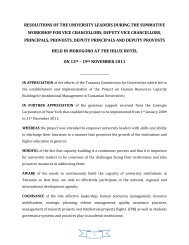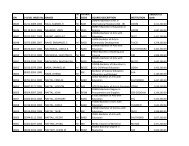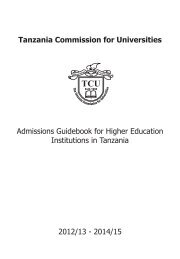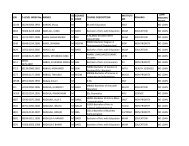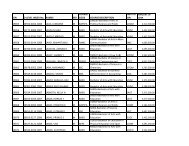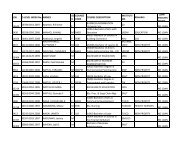Handbook for Quality Assurance in Higher Education The ... - TCU
Handbook for Quality Assurance in Higher Education The ... - TCU
Handbook for Quality Assurance in Higher Education The ... - TCU
You also want an ePaper? Increase the reach of your titles
YUMPU automatically turns print PDFs into web optimized ePapers that Google loves.
How to use the model<br />
1. <strong>The</strong> criteria to be met are given <strong>in</strong> section 2, under the head<strong>in</strong>g of the aspect (e.g.2: Ex<br />
pected learn<strong>in</strong>g outcomes, or 12:Facilities & <strong>in</strong>frastructure) .<br />
We have to keep <strong>in</strong> m<strong>in</strong>d that there are no absolute and objective criteria and standards. <strong>The</strong><br />
criteria <strong>for</strong> assess<strong>in</strong>g the quality given <strong>in</strong> the handbook are based on:<br />
• <strong>The</strong> common denom<strong>in</strong>ator of the criteria as <strong>for</strong>mulated by the three national regulatory<br />
agencies<br />
• <strong>The</strong> criteria as <strong>for</strong>mulated <strong>in</strong> the Entebbe matrix<br />
• <strong>The</strong> criteria as <strong>for</strong>mulated by external quality assessment agencies, e.g. European,<br />
American, Asian, Australian and South African accredit<strong>in</strong>g bodies, among others. After<br />
study<strong>in</strong>g many sets of standards and criteria, a common denom<strong>in</strong>ator has been<br />
<strong>for</strong>mulated. To verify compliancy of its own criteria, a university can use the regional<br />
criteria as benchmark.<br />
In general, one may say that the <strong>for</strong>mulated criteria can be seen as the m<strong>in</strong>imum requirements.<br />
If needed, an explanation and <strong>in</strong>terpretation of the criteria is given.<br />
2. <strong>The</strong> self-assessment aims at f<strong>in</strong>d<strong>in</strong>g evidence that the faculty/department is meet<strong>in</strong>g the<br />
criteria. <strong>The</strong>re<strong>for</strong>e, one has to look at the criteria and try to f<strong>in</strong>d <strong>in</strong>dications of meet<strong>in</strong>g the<br />
criteria:<br />
• Give a description of the state-of-the-art of the aspect<br />
• Make a critical analysis of the state-of-the-art. (Is one satisfied with it or not?)<br />
• Describe the strengths and weaknesses concern<strong>in</strong>g the mentioned aspect<br />
• F<strong>in</strong>d evidence that you are meet<strong>in</strong>g the criteria?<br />
• If there are problems or if you are not satisfied, plan actions to overcome the shortcom<strong>in</strong>gs?<br />
3. To help you to f<strong>in</strong>d evidence, a set of questions are <strong>for</strong>mulated under the head<strong>in</strong>g “look<strong>in</strong>g<br />
<strong>for</strong> evidence” that can be used <strong>in</strong> f<strong>in</strong>d<strong>in</strong>g the needed <strong>in</strong>dications. This is not a conclusive list.<br />
Note that the questions are not to be seen as a questionnaire that needs to be completed, but<br />
they are guides on what to look <strong>for</strong>.<br />
If it is the first time the faculty/department is <strong>in</strong>volved <strong>in</strong> a structured self-assessment, there<br />
will be a lot of blank spots. It will not always be possible to fill all segments. So a number of<br />
aspects will be left unanswered this time, but will <strong>for</strong>ce the faculty to take action. Do not worry<br />
about it. This is someth<strong>in</strong>g <strong>for</strong> the future.<br />
Guidel<strong>in</strong>es <strong>for</strong> Self Assessment<br />
15<br />
IUCEA/ CHE/ NCHE/ <strong>TCU</strong>/ DAAD



